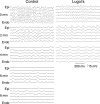Chemical ablation of the Purkinje system causes early termination and activation rate slowing of long-duration ventricular fibrillation in dogs
- PMID: 18586887
- PMCID: PMC2519198
- DOI: 10.1152/ajpheart.00466.2008
Chemical ablation of the Purkinje system causes early termination and activation rate slowing of long-duration ventricular fibrillation in dogs
Abstract
Endocardial mapping has suggested that Purkinje fibers may play a role in the maintenance of long-duration ventricular fibrillation (LDVF). To determine the influence of Purkinje fibers on LDVF, we chemically ablated the Purkinje system with Lugol solution and recorded endocardial and transmural activation during LDVF. Dog hearts were isolated and perfused, and the ventricular endocardium was exposed and treated with Lugol solution (n = 6) or normal Tyrode solution as a control (n = 6). The left anterior papillary muscle endocardium was mapped with a 504-electrode (21 x 24) plaque with electrodes spaced 1 mm apart. Transmural activation was recorded with a six-electrode plunge needle on each side of the plaque. Ventricular fibrillation (VF) was induced, and perfusion was halted. LDVF spontaneously terminated sooner in Lugol-ablated hearts than in control hearts (4.9 +/- 1.5 vs. 9.2 +/- 3.2 min, P = 0.01). After termination of VF, both the control and Lugol hearts were typically excitable, but only short episodes of VF could be reinduced. Endocardial activation rates were similar during the first 2 min of LDVF for Lugol-ablated and control hearts but were significantly slower in Lugol hearts by 3 min. In control hearts, the endocardium activated more rapidly than the epicardium after 4 min of LDVF with wave fronts propagating most often from the endocardium to epicardium. No difference in transmural activation rate or wave front direction was observed in Lugol hearts. Ablation of the subendocardium hastens VF spontaneous termination and alters VF activation sequences, suggesting that Purkinje fibers are important in the maintenance of LDVF.
Figures






References
-
- AHA Special Report. Position of the American Heart Association on research animal use. Circulation 71: 849A–850A, 1985. - PubMed
-
- Allison JS, Qin H, Dosdall DJ, Huang J, Newton JC, Allred JD, Smith WM, Ideker RE. The transmural activation sequence in porcine and canine left ventricle is markedly different during long-duration ventricular fibrillation. J Cardiovasc Electrophysiol 18: 1306–1312, 2007. - PubMed
-
- Antzelevitch C, Sicouri S, Litovsky SH, Lukas A, Krishnan SC, Di Diego JM, Gintant GA, Liu DW. Heterogeneity within the ventricular wall: electrophysiology and pharmacology of epicardial, endocardial, and M cells. Circ Res 69: 1427–1449, 1991. - PubMed
-
- Arnar DO, Bullinga JR, Martins JB. Role of the Purkinje system in spontaneous ventricular tachycardia during acute ischemia in a canine model. Circulation 96: 2421–2429, 1997. - PubMed
-
- Arnar DO, Martins JB. Purkinje involvement in arrhythmias after coronary artery reperfusion. Am J Physiol Heart Circ Physiol 282: H1189–H1196, 2002. - PubMed
Publication types
MeSH terms
Substances
Grants and funding
LinkOut - more resources
Full Text Sources
Other Literature Sources

